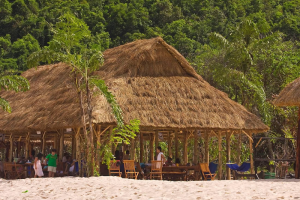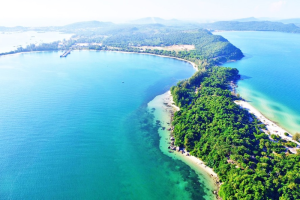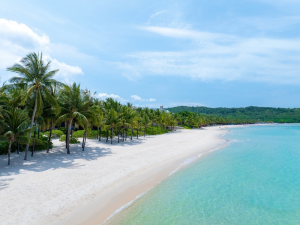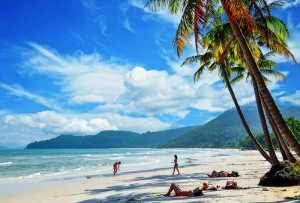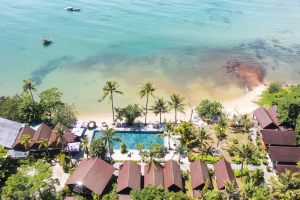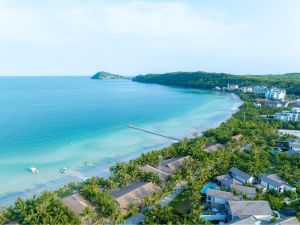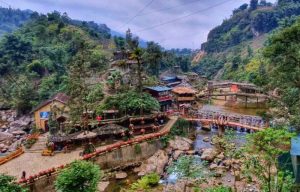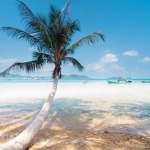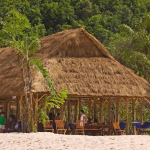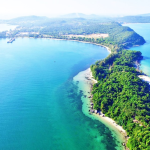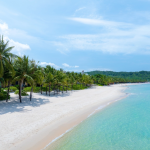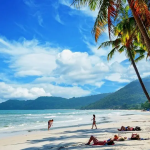Hoang Sa Island (the Paracel Islands) is a stunning archipelago legally belonging to Vietnam under international law. While its breathtaking natural beauty and strategic location are undeniable, sovereignty over Hoang Sa Islands remains disputed. If you are planning to visit this gorgeous island, the article below indeed gives you detailed information.
Overview of Hoang Sa Island (Paracel Islands)
Hoang Sa Island Vietnam is a coral archipelago scattered within a range from approximately 111° East to 113° East longitude and from 15°45’ North to 17°15’ North latitude, aligned with Hue and Da Nang, outside the mouth of the Gulf of Tonkin, in the northern part of the South China Sea.

This archipelago consists of more than 37 islands, reefs, and shoals, divided into two main groups:
- The Crescent Group (Nhóm đảo Lưỡi Liềm): Located in the western part of the archipelago, closer to the Vietnamese mainland, this group features islands arranged in a crescent or sickle shape. Key islands in this group include Hoang Sa (Pattle Island), Quang Anh (Money Island), Huu Nhat (Robert Island), Duy Mong (Drummond Island), Quang Hoa (Duncan/Palm Island), Bach Quy (Passu Keah), and Tri Ton (Triton Island), along with various reefs and banks such as Da Bac (North Reef). Hoang Sa Island itself, despite not being the largest, is considered the main island of this group and holds significant military importance for coastal defense.
- The Amphitrite Group (Nhóm đảo An Vĩnh): Situated in the eastern part of the Hoang Sa Island Vietnam archipelago, this group contains the relatively larger coral islands. Notable islands here include Phu Lam (Woody Island), Cay (Tree Island), Linh Con (Lincoln Island), Trung (Middle Island), Bac (North Island), Nam (South Island), and Da (Rocky Island), accompanied by several reefs and banks like Da Bong Bay (Bombay Reef) and Bai Binh Son (Iltis Bank). Phu Lam Island is considered the most crucial island within the Amphitrite Group and the entire Hoang Sa archipelago.
The Hoang Sa Islands, vital to Vietnam, shine in the South China Sea for their strategic location along key shipping routes, linking the Pacific and Indian Oceans. Rich in fishery resources and potential oil and gas, they also boast a biodiverse coral ecosystem with valuable marine life.

Hoang Sa Vietnam, boasts a monsoon-driven climate with warm temperatures (23°C-29°C), high humidity, and typhoons from June to November. Its diverse vegetation hails from coastal Vietnam, while abundant marine life like lobsters, turtles, clams thrive amid over 100 coral species.
Historical background of Hoang Sa Island
Hoang Sa Island and the Truong Sa islands Vietnam have long been regarded as sacred, inseparable parts of Vietnam’s territory. Vietnam was the first state in history to establish and exercise sovereignty over these two archipelagos when they were still unclaimed.

Together with the Truong Sa archipelagos, Vietnam’s sovereignty over the Hoang Sa Island is supported by historical and legal evidence recognized globally. From the 17th century, Vietnamese maps showed these islands as the “Golden Sandbank,” and the Nguyen Lords formed the Hoang Sa team to manage resources and aid ships.
For three centuries, Vietnam’s feudal states exercised uninterrupted sovereignty, documented in texts like “Toan Tap Thien Nam Tu Chi Lo Do Thu” (1686) and the 1827 Belgian “World Atlas,” listing Hoang Sa under the Kingdom of Annam. The Nguyen Dynasty’s UNESCO-recognized archives (1802-1945) further confirm this through various activities.
In 1974, China illegally occupied Hoang Sa by force, an action that violated international law and did not establish any legal rights for China over the archipelago. Vietnam possesses sufficient historical and legal evidence to assert and defend its sovereignty over Hoang Sa Island of Vietnam. In 1975-1976, Vietnam reaffirmed its sovereignty over the Hoang Sa Islands.
Can tourists visit Hoang Sa Island?
Currently, direct tourism to the Hoang Sa Islands (located in Da Nang City) for travelers is not a readily available option due to ongoing territorial disputes. This geopolitical tension leads to restricted access and military presence in the region. However, there are several beautiful and accessible islands near the Hoang Sa Islands’ general region in Vietnam that are popular for travelers. Below are some notable options that you might consider for a similar thrilling island getaway:
Ly Son Island
Ly Son Island, located in Quang Ngai Province about 15 miles (24 km) off Vietnam’s south-central coast, roughly 200 miles (320 km) west of the Hoang Sa Islands. A trip to this place provides tourists with experiences of exploring and widening knowledge about rich cultural tapestry.

Ly Son Island stands out for its volcanic origins, featuring dramatic craters and cliffs sculpted by ancient eruptions. Known as the “Kingdom of Garlic,” its rich basaltic soil yields unique, mild-flavored garlic. Pristine reefs, clear waters, and a distinct cultural heritage further enhance its allure.
Cham Island (Cu Lao Cham)
Cham Island is located 18 kilometers off Hoi An in Vietnam’s South China Sea, is approximately 300 to 350 kilometers northwest of the Hoang Sa Islands. Cham Island stands out as a UNESCO Biosphere Reserve, boasting pristine beaches, vibrant coral reefs, and lush forests across its eight-island cluster.

This island also offers captivating activities. While snorkeling and diving reveal vibrant coral reefs teeming with marine life, kayaking showcases stunning coastal views right in front of you. Trekking forested trails leads to scenic peaks, and exploring fishing villages and ancient Cham relics also broaden your knowledge of the island’s rich heritage.
Read more: Hoi An to My Son Sanctuary: Epic day trip
Phu Quoc Island
Phu Quoc Island is located in Kien Giang Province, about 500 miles (800 km) southwest of Hoang Sa Vietnam. This island earns its title as Vietnam’s most worth-visiting destination for its unique untouched natural beauty with vibrant coral reefs, teeming with marine life. Spanning over 31,000 hectares, Phu Quoc National Park, a UNESCO-recognized park, covers more than half the island, featuring dense tropical forests, waterfalls, and diverse wildlife.

The cuisine of Phu Quoc Island tantalizes with countless specialties, showcasing its coastal bounty. Fresh seafood, like grilled herring and sea urchin, delights the palate, while the island’s famed fish sauce adds depth to dishes. Unique offerings, such as flower crab soup and pepper-spiced delicacies, reflect Phu Quoc’s rich culinary heritage.
Read more: Best things to do in Phu Quoc
Frequently Asked Questions (FAQ) about Hoang Sa Island
Why is Hoang Sa Island disputed?
The islands are disputed due to their strategic location in the South China Sea, a vital shipping route, and their potential reserves of oil and natural gas. Multiple countries – Vietnam, China, and Taiwan claim historical and legal rights to the area.
Are there natural resources in the Hoang Sa Islands?
The Hoang Sa Islands are believed to sit atop significant oil and gas reserves, though exploration has been limited due to the ongoing dispute. The area is also a rich fishing ground.

What is Woody Island in the Hoang Sa Islands, and why is it important?
Woody Island (Phu Lam in Vietnamese) is the largest island in the Hoang Sa Islands, is strategically important due to territorial disputes and military presence. This region has commercially valuable marine resources, including fisheries and potential offshore oil and gas reserves.
Why should tourists choose Lily’s Travel for trips
In case you need a reliable partner to handle all your travel plans, just look no further than Lily’s Travel for some below reasons:
- High prestige: Established since 2007, we’ve been crafting thrilling journeys, and with over 2,000 five-star reviews on TripAdvisor. Plus, our cutting-edge tech lets you preview your trip before you book.
- Diverse options: We provide travellers with various tours to many attractions throughout Vietnam, Laos and Cambodia.
- Enthusiastic supporters: Our young, passionate team is dedicated to responsible travel, supporting local communities, and ensuring you experience authentically.
- High-quality services: If you are struggling with itinerary, visa, booking for hotels, flights and other means of transport, let us do that for you. We even provide customized tours, allowing travelers freely to choose their destinations, travel times, types of experiences, and accompanying services instead of following fixed schedules.

If you’re seeking more than just a vacation, let’s make it an adventure together with Lily’s Travel!
Contact us through Tel/WhatsApp/Viber: +84931152368
While the Hoang Sa Island holds immense natural beauty and historical significance, conflicts happening here mean that direct tourism for travelers is not a feasible option at present. We hope the above article has provided you with all the detailed information you need.




